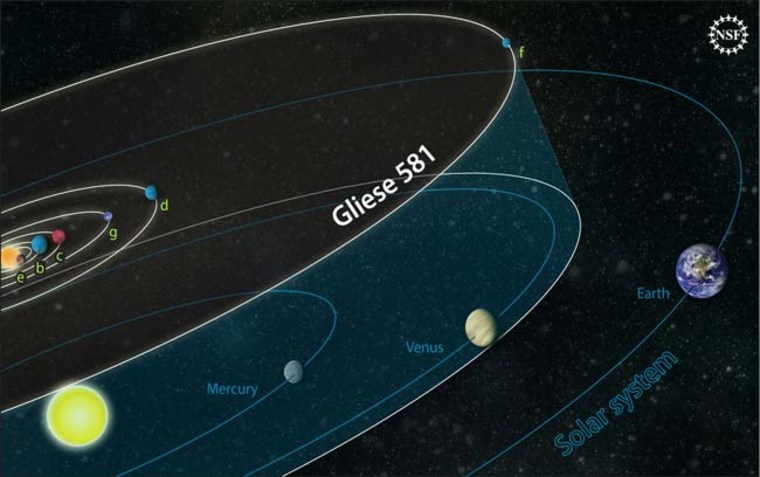The alien planet Gliese 581g has been getting a lot of attention recently as a possibly habitable world, but a case is building for its next-door neighbor as a good candidate for extraterrestrial life, too.
Gliese 581d, another planet discovered around the star Gliese 581, may well lie in the "habitable zone" of the star — that just-right distance range that can allow liquid water to exist — new atmospheric-modeling research suggests. The finding follows closely on the heels of a similar study, published earlier this year, that reached the same provisional conclusion. [Tour of the planets around star Gliese 581.]
"The fact that two models find conditions for liquid water could exist, that strongly implies that it is possible," said the new study's lead author, Philip von Paris of the Institute for Planetary Research at the German Aerospace Center in Berlin. "It doesn't seem impossible to have life there."
The Gliese 581 system: Worlds of possibilities
Gliese 581 is a red dwarf located 20 light-years from Earth, just a stone's throw in the cosmic scheme of things. Astronomers have detected six planets orbiting the star.
Gliese 581g is about three times as massive as Earth, and it's likely a rocky world. It also lies right in the middle of the habitable zone, making it a prime candidate for liquid water and life as we know it — if the planet exists.
But some researchers question the analysis used to discover the planet, and say they cannot confirm 581g in follow-up studies. The planet's discoverers, however, are standing by their find.
The two planets on either side of 581g skirt the edges of the habitable zone and thus have inspired interest and intrigue since their discovery in 2007. Gliese 581g's interior neighbor, 581c, was once thought a good candidate for liquid water, but studies have shown that a greenhouse effect likely makes the planet too hot.
Gliese 581d, on the other hand, orbits outside of 581g, far enough away that researchers first thought it too cold for life. But a strong greenhouse effect may warm 581d up substantially, perhaps enough to support liquid water, according to the new study.
Modeling an alien atmosphere
Gliese 581d is probably seven to eight times as massive as Earth, and astronomers suspect it's rocky like our home planet. The alien world's gravity is likely strong enough to hold onto an atmosphere, though researchers have yet to confirm and characterize 581d's air.
Von Paris and his team modeled the surface conditions that could result on 581d from several different types of atmosphere, using our own solar system as a guide. They assumed, for example, an atmosphere composed of water vapor, carbon dioxide and nitrogen — all of which are found in the air of the rocky planets Earth, Mars and Venus.
The research team ran simulations at different concentrations of carbon dioxide, mimicking the levels found in our solar system. Various runs assumed different amounts of CO2 mirroring the levels found on Earth now, on the early Earth and on Mars and Venus now.
The team's model also varied atmospheric pressure from low to high.
In the end, the researchers found that several of these atmospheric scenarios resulted in average surface temperatures above 32 degrees Fahrenheit (0 degrees Celsius) — meaning Gliese 581d might well harbor liquid water.
A medium- or high-pressure atmosphere with 95 percent CO2 would do the trick, they found. So would a high-pressure one with just 5 percent CO2.
"I found it quite exciting that, even for the 5 percent carbon dioxide atmosphere, we obtained habitable conditions in one case," von Paris told SPACE.com.
Von Paris and his colleagues published their results in the November issue of the journal Astronomy & Astrophysics.
Lots of caveats
Another atmospheric-modeling study published earlier this year also suggested that a strong greenhouse effect — driven by lots of CO2 — could make Gliese 581d warm enough for liquid water. Other research teams have reached similar conclusions over the past several years.
Such work, while intriguing, remains provisional and speculative. Von Paris and his team looked to our own solar system for guidance, but their model is based on educated guesses.
"The problem, of course, is that you don't know anything about the atmosphere," von Paris said.
Astronomers aren't even sure that Gliese 581d is a rocky planet, like Earth or Mars or Venus. They think it is, based on its size, but further research will be needed to confirm this.
While von Paris is the first to mention such caveats and unknowns, he's excited by the possibility that 581d could support liquid water — especially since the universe is so vast and the hunt for alien planets is still in its infancy. While astronomers have detected more than 500 alien worlds, the first one was discovered less than 20 years ago, in 1992.
"Gliese 581 is our next-door neighbor, among the 100 nearest stars," von Paris said. "My point of view is, this kind of implies that such planets may be reasonably common."
- Gallery: Strangest Alien Planets
- Top 10 Extreme Planet Facts
- A Million Questions About Habitable Planet Gliese 581g (Okay, 12)
- You can follow SPACE.com senior writer Mike Wall on Twitter:
